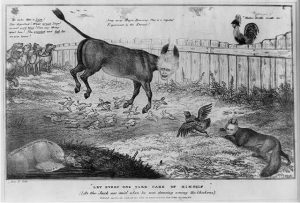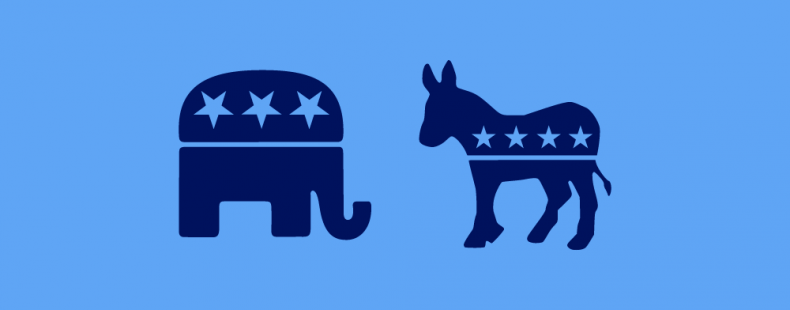While the bald eagle is a national symbol for the United States, the two major political parties that govern it are often represented by two different animals: a donkey for the Democratic Party and an elephant for the Republican Party. These animals are commonly linked with these two parties in everything from political analysis to bumper stickers.
Why these two animals, though? Why not an ostrich and an alpaca, or some other unlikely combo? Incredibly, the popularization of both the donkey and the elephant being associated with the parties can be traced back to one person: cartoonist Thomas Nast.
Was the donkey originally a jackass?
Thomas Nast was an American cartoonist who joined the staff of Harper’s Weekly in 1862. Nast’s cartoons were very popular and his depiction of Santa Claus is still the most widely used version of the holiday icon we see today. During his career, Nast also drew many political cartoons that harshly criticized the policies of both parties.
Nast first used a donkey to represent the Democratic party as a whole in the 1870 cartoon “A Live Jack-Ass Kicking a Lion” in which Nast criticized the dominantly Democratic Southern newspaper industry as the “Copperhead Press.” While he did popularize the donkey, Nast wasn’t the first person to use it in reference to the Democrats.
Over 40 years earlier during the presidential campaign of 1828, opponents of Democrat Andrew Jackson referred to him as a “jackass.” Jackson actually embraced the insult and used donkeys on several campaign posters. Nevertheless, cartoonist Anthony Imbert would use a Jackson-headed donkey to mock Jackson an 1833 political cartoon.

Anthony Imbert/Library of Congress
However, the donkey never really caught on after the end of Jackson’s presidency, and Thomas Nast apparently had no knowledge that it ever was used to represent the Democrats.
What does the elephant symbolize?
As for the elephant, Nast first used the behemoth to represent the Republicans in the 1874 cartoon “The Third Term Panic.” The cartoon depicts the Republican Party as a lumbering elephant about to walk off a cliff. As for why Nast chose an elephant, a common theory is that it is based on an old phrase of “seeing the elephant” which pro-Unionist Republicans used to mean that they had seen battle during the Civil War. Nast himself was a proud Republican and diehard-Unionist so it is entirely plausible he was aware of this phrase at the time.

Thomas Nast/Library of Congress
Thomas Nast worked at Harper’s Weekly until 1886. It is an understatement to say that Nast’s cartoons were extraordinarily popular. President Abraham Lincoln referred to Nast as his “best recruiting sergeant” and President Ulysses S. Grant, one of the highest ranking Union generals, said that Nast had done as “much as any one man to preserve the Union and bring the war to an end.”
With praise like that (albeit from fellow Republicans), it isn’t hard to figure out why his symbolic animals would catch on with the public and other cartoonists as early as 1896. By 1926, Republicans were already embracing the elephant as an unofficial animal. By 1928, some Democrats were also acknowledging the donkey as their unofficial animal as well. In 1932, both animals were used as symbols of the parties on an official campaign poster for Republican incumbent Herbert Hoover.
Today, the Republican Party uses the elephant as an official logo and you will find it all over their web site and on plenty of official Republican merchandise. While the Democrats have never officially embraced the donkey as a symbol, the animal is used to represent the party by the media and is placed on a plethora of unofficial Democratic party merchandise.
How do we use mascots in political communication?
Democrats and Democratic candidates have often embraced the donkey as their unofficial mascot:
Happy 150th birthday to the Democratic donkey! Originally intended to be insulting, we embraced the comparison with such a tough, hardworking creature. From protecting union rights to fighting for affordable healthcare, I'm proud to stand with working-class Coloradans.#COPolitics pic.twitter.com/qmrheP0cIt
— Daneya Esgar (@Dlesgar) January 15, 2020
When your son makes you a Father’s Day card with a hand drawn Democratic donkey, you know you’ve done alright. #FathersDay #BlueWave pic.twitter.com/VXt59UENk5
— Chris King (@ChrisKingFL) June 21, 2020
The animals began in political cartoons and still appear in many of them today. CNN featured both animals in animated political cartoon ads that depicted them as friends:
The Republican elephant and Democratic donkey are longtime friends in CNN's artful new election coverage ads. https://t.co/vC5meK7Hr4
— Adweek (@Adweek) August 29, 2020
Some conservative Republicans criticize liberal Republicans as being RINOs (Republicans in Name Only) and often have (rhi)no sympathy for these “left-leaning” politicians. In recent years, some members of the Libertarian Party have unofficially embraced the porcupine as the unofficial animal mascot of the party.
Will these mascots eventually catch on like the donkey and the elephant? It’s hard to tell! The stories of the donkey and the elephant certainly have their own surprising twists and turns, and would have been hard to predict.
Did you know the United States is a democratic republic? That helps in understanding the origin of the two major party names: Democrat and Republican. Learn more about the party names here.










